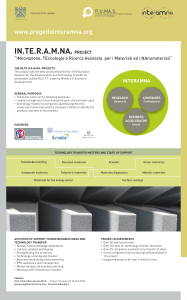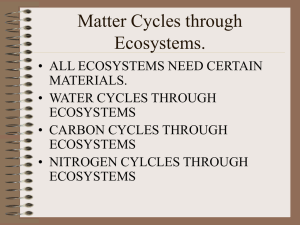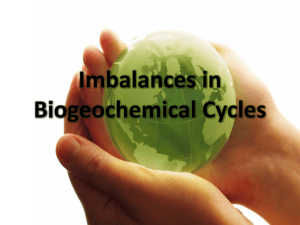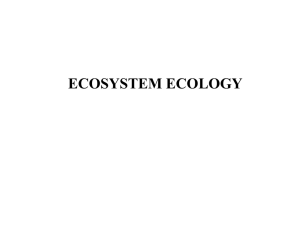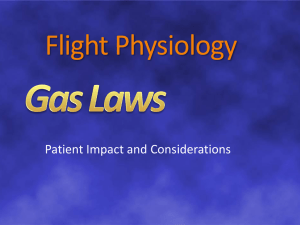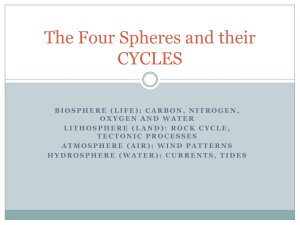ANALYSIS OF AN INNOVATIVE INLET AIR COOLING SYSTEM
advertisement
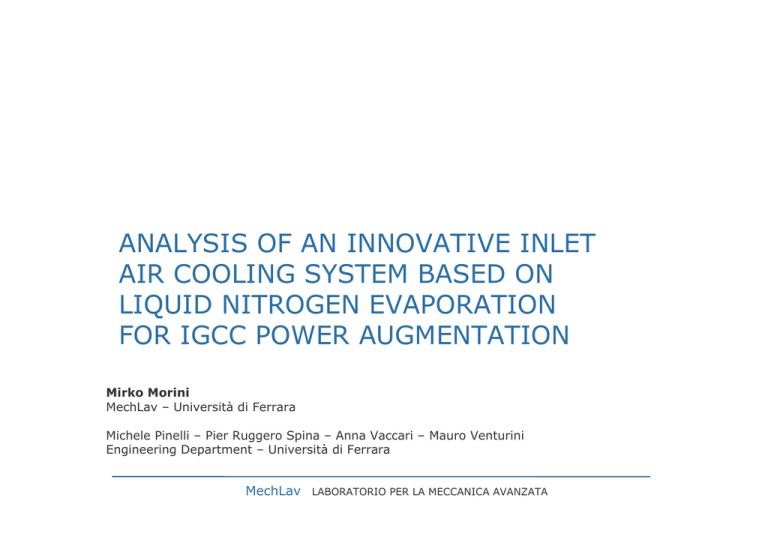
ANALYSIS OF AN INNOVATIVE INLET AIR COOLING SYSTEM BASED ON LIQUID NITROGEN EVAPORATION FOR IGCC POWER AUGMENTATION Mirko Morini MechLav – Università di Ferrara Michele Pinelli – Pier Ruggero Spina – Anna Vaccari – Mauro Venturini Engineering Department – Università di Ferrara MechLav LABORATORIO PER LA MECCANICA AVANZATA Summary IGCCs are energy systems mainly composed of a gasifier and a combined cycle power plant. Since the gasification process usually requires oxygen as the oxidant, the plant also has an Air Separation Unit. Since these plants are based on gas‐steam combined cycle power plants they suffer from a reduction in performance when ambient temperature increases. In this paper, an innovative system for power augmentation in IGCC plants has been presented. The system is based on gas turbine inlet air cooling by means of liquid nitrogen spray. In fact, nitrogen is a product of the ASU, but is not always exploited. In the proposed plant, the nitrogen is first chilled and liquefied and then it can be used for inlet air cooling or stored for a postponed use. This system is not characterized by the limits of water evaporative cooling (where the lower temperature is limited by air saturation) and refrigeration cooling (where the effectiveness is limited by pressure drop in the heat exchanger). MechLav LABORATORIO PER LA MECCANICA AVANZATA Inlet air cooling technologies Many strategies for inlet air cooling have been proposed in recent years. These technologies can be grouped into two main categories: •Evaporative cooling is based on the adiabatic evaporation of water in air which causes an increase in air humidity and a reduction in air temperature to wet bulb temperature. •Refrigeration is based on the use of a cold stream (e.g. water) which exchanges heat with the compressor inlet air by means of a cooling coil. The profitability of inlet air cooling systems is strongly dependent on the location of the plant. MechLav LABORATORIO PER LA MECCANICA AVANZATA Liquid nitrogen Liquid nitrogen latent heat of vaporization in currently used in food freezing and chilling applications. The innovative system for power augmentation in IGCC plants imagined in this work consists of the liquefaction of the nitrogen stream which is usually discharged by the ASU by using an electric chiller. Then, the liquefied nitrogen can be directly sprayed into the inlet duct of the gas turbine as done for industrial fast freezing and chilling. Moreover, liquid nitrogen can operate as thermal energy storage: the nitrogen is produced during nightime when electricity is cheap and used in daytime when electricity is expensive. MechLav LABORATORIO PER LA MECCANICA AVANZATA The model air oxygen nitrogen syngas flue gas 66.9 kg/s In order to implement the power augmentation system some modifications to the model of a traditional IGCC are performed: 27.4 kg/s ASU 55.8 kg/s G GC 649.9 kg/s GT SS 68.1 kg/s •ASU is designed in order to allow the production of a stream of 100 kg/s of high pressure (10 bar) nitrogen (this does not significantly increase the size of the ASU since this stream is mostly recuperated from the gases usually discharged by the ASU); 100.0 kg/s EC 641.0 kg/s ST 2.3 kg/s 66.9 kg/s AMBIENT Gross power [MW] 409.3 Total auxiliaries [MW] 70.8 •an electric chiller (COP = 3) is added in ASU [MW] 39.8 order to liquefy the high pressure nitrogen. Electric chiller [MW] 17.1 Net power [MW] 333.8 Net electric [%] 39.6 efficiency with respect to 377.9 MW MechLav LABORATORIO PER LA MECCANICA AVANZATA Plant operating mode 66.9 kg/s 27.4 kg/s ASU air oxygen nitrogen syngas flue gas 55.8 kg/s G GC 649.9 kg/s GT SS air oxygen nitrogen syngas flue gas ASU G GC GT SS 68.1 kg/s 100.0 kg/s EC 641.0 kg/s < 100.0 kg/s ST IACS ST 2.3 kg/s 66.9 kg/s AMBIENT AMBIENT Off peak Peak MechLav LABORATORIO PER LA MECCANICA AVANZATA Performance maps 400 In order to simulate the behavior of the plant in the four selected locations, plant performance maps are built 350 250 200 -20 nitrogen production - RH = 100 % nitrogen production - RH = 10 % inlet air cooling - RH = 100 % inlet air cooling - RH = 10 % IGCC normal operation - RH = 100% IGCC normal operation - RH = 10 % -10 0 10 20 30 40 50 Ambient temperature [°C] 100 inlet air cooling - RH = 100 % inlet air cooling - RH = 10 % 75 50 2 300 N [kg/s] Net Power [MW] 450 25 0 5 10 15 20 25 30 35 40 45 Ambient temperature [°C] MechLav LABORATORIO PER LA MECCANICA AVANZATA Effect of nitrogen injection The injection of a large amount of liquid nitrogen at gas turbine inlet can seen disputable. To investigate the effect of this procedure simulations are carried out by varying the liquid nitrogen mass flow rate for a given ambient condition. 25 Air composition changes, thought not considerably, after nitrogen injection. Ambient temperature = 45 °C Ambient relative humidity = 60 % oxygen molar fraction [%] 20 The oxygen content seems always high enough to allow a regular combustion. 15 10 Ambient air GT inlet air Exhaust gas 5 0 20 40 60 80 100 Anyway local effects will be further investigated. liquid nitrogen mass flow rate [kg/s] MechLav LABORATORIO PER LA MECCANICA AVANZATA Nitrogen enrichment The main effect of adding nitrogen to the gas turbine inlet air is the reduction of the oxygen molar fraction in the oxidant stream. In literature, the combustion in gas turbines with low oxygen concentration has been investigated mainly for two different technologies: (i) exhaust gas recirculation (EGR) and (ii) humidified gas turbines. According to literature, the EGR is limited to the minimum oxygen content in the combustion air, which is evaluated in 16 % ‐ 18 %. In this paper, a small scale combustion chamber geometry (330 kWth) is taken into consideration since its model has been widely validated by the Authors. •Analyzed cases (@ constant volume flow rate) S1 ‐ a standard dry air composition (79 % N2, 21 % O2) S2 ‐ an N2‐enriched air (83 % N2, 17 % O2) S3 ‐ a standard dry air composition (79 % N2, 21 % O2) + 2 % water overspray MechLav LABORATORIO PER LA MECCANICA AVANZATA Test Combustor Geometry o Reverse flow tubular combustor which is part of a 100 kW Micro Gas Turbine for which full validated model and experimental data are available o Two fuel supply lines: pilot line (diffusive combustion), main line (premixed combustion) o Reference fuel distribution: 15 % pilot line, 85 % main line OUTER FLAME TUBE SPARKPLUG PILOT FUEL LINE SECONDARY SWIRLER LINER Air inlet Main fuel line Pilot fuel line MAIN FUEL LINE PRIMARY SWIRLER DILUITION HOLES INNER FLAME TUBE MechLav Air inlet LABORATORIO PER LA MECCANICA AVANZATA Results: velocity distributions Syngas feeding No significant variation of the velocity field can be highlighted. A variation in the velocity field is noticeable only downstream of the dilution holes. S1 S2 S3 MechLav LABORATORIO PER LA MECCANICA AVANZATA Results: velocity distributions S1 S2 MechLav LABORATORIO PER LA MECCANICA AVANZATA Results: temperature distributions Syngas feeding Reduction of the temperature in the primary combustion zone: in the case of both nitrogen (S2) and water vapor (S3) air vitiation. This is due to the fact that nitrogen and water vapor are characterized by a higher specific heat and, therefore, for a given heat release the increase of exhaust gas temperature is lower. The effect of nitrogen vitiation is even lower when syngas feeding is considered: the higher combustion reactivity of the hydrogen than methane mitigates the effect of the oxygen dilution. S1 Non dimensional temperature S2 S3 MechLav LABORATORIO PER LA MECCANICA AVANZATA Effect of nitrogen injection The trend is not linear in the whole investigated range of nitrogen mass flow rate. 50 Ambient temperature = 45 °C Ambient relative humidity = 60 % inlet air temperature [°C] 45 40 When the temperature decreases under the dew point temperature part of the liquid nitrogen is used for water condensation. 35 30 25 20 0 20 40 60 80 100 liquid nitrogen mass flow rate [kg/s] MechLav For this reason, the rate of temperature reduction decreases after this temperature. LABORATORIO PER LA MECCANICA AVANZATA Effect of liquid water at GT inlet When warm humid air is cooled by spraying liquid nitrogen, the air can saturate by forming liquid water. This fine dispersed fog enters into the gas turbine and contributes to a further gas turbine power augmentation as wet compression or overspray. The curves at different humidity diverge. When the target inlet air temperature cannot be achieved due to high water content in the air the gas turbine power decreases by increasing the ambient temperature as the gas turbine inlet air increases. MechLav LABORATORIO PER LA MECCANICA AVANZATA Locations Since the effectiveness of power augmentation technologies proved to be strictly related to climatic conditions four locations around the world have been chosen. Dubai Ferrara Darwin Johannesburg MechLav LABORATORIO PER LA MECCANICA AVANZATA Climatic data 65% 55% 50% relative frequency 45% 40% 35% 30% 25% 20% 65% > 95 % 85 to 95 % 75 to 85 % 65 to 75 % 55 to 65 % 45 to 55 % 35 to 45 % 25 to 35 % 15 to 25 % RH < 15 % > 95 % 85 to 95 % 75 to 85 % 65 to 75 % 55 to 65 % 45 to 55 % 35 to 45 % 25 to 35 % 15 to 25 % RH < 15 % 60% 55% 50% 45% relative frequency 60% 15% 10% 5% 40% 35% 30% 25% 20% 15% 10% 5% 0% < -5 °C -5 to 5 °C 5 to 15 °C 15 to 25 °C 25 to 35 °C 35 to 45 °C 0% > 45 °C < -5 °C -5 to 5 °C Ambient temperature Ferrara 65% 65% 50% relative frequency 45% 40% 35% 30% 25% 20% > 95 % 85 to 95 % 75 to 85 % 65 to 75 % 55 to 65 % 45 to 55 % 35 to 45 % 25 to 35 % 15 to 25 % RH < 15 % > 95 % 85 to 95 % 75 to 85 % 65 to 75 % 55 to 65 % 45 to 55 % 35 to 45 % 25 to 35 % 15 to 25 % RH < 15 % 60% 55% 50% 45% relative frequency 55% > 45 °C Ambient temperature Darwin 60% 5 to 15 °C 15 to 25 °C 25 to 35 °C 35 to 45 °C 15% 10% 40% 35% 30% 25% 20% 15% 10% 5% 5% 0% 0% < -5 °C -5 to 5 °C 5 to 15 °C 15 to 25 °C 25 to 35 °C 35 to 45 °C < -5 °C > 45 °C -5 to 5 °C 5 to 15 °C 15 to 25 °C 25 to 35 °C 35 to 45 °C > 45 °C Ambient temperature Ambient temperature Johannesburg Dubai MechLav LABORATORIO PER LA MECCANICA AVANZATA Dew point temperature Dew point temperature can be considered as an index of the limit temperature for evaporative cooling. For some localities (Darwin, Dubai), the dew point temperature in summer time is always higher than 15 °C (black dotted line), and, therefore, evaporative cooling cannot provide suitable power augmentation. MechLav LABORATORIO PER LA MECCANICA AVANZATA Model application Electrical energy [TWh/yr] Peak Off Peak Tot. Peak IGCC Off Peak Tot. NC Darwin 0.99 2.08 3.07 1.08 2.01 3.10 Dubai 0.97 2.05 3.02 1.07 1.98 3.06 Ferrara 1.07 2.25 3.31 1.10 2.22 3.32 Johannesburg 1.05 2.24 3.29 1.08 2.22 3.30 The power augmentation strategies proposed lead to an increase in the total electrical energy produced. MechLav LABORATORIO PER LA MECCANICA AVANZATA Model application Coal [Mt/yr] Efficiency [%] Coal Off Peak [Mt/yr] Peak Tot. Efficiency [%] Peak IGCC Off Peak Tot. NC Darwin 1.19 41.3 41.5 41.5 1.23 41.3 40.4 40.7 Dubai 1.17 41.4 41.5 41.5 1.21 41.4 40.5 40.8 Ferrara 1.27 42.1 42.2 42.2 1.28 42.0 41.8 41.9 Johannesburg 1.26 42.1 42.3 42.2 1.27 42.1 41.9 42.0 The increase in electrical energy production is obtained through higher coal consumption, with the annual average efficiency decreasing. MechLav LABORATORIO PER LA MECCANICA AVANZATA Economic results In order to present some basic economic considerations about the profitability of the system it is assumed that: •peak hours run from 8:00 a.m. to 7 p.m. Monday to Friday; •the value of electrical energy during peak hours is 100 €/MWh, while during off peak hours it is 50 €/MWh; •the price of coal is equal to 100 €/t; •extra costs for maintenance are not considered. IGCC NC TEC HPF OS CCC Cash Flow Diff. Diff. Diff. Diff. Diff. [M€/yr] [M€/yr] [M€/yr] [M€/yr] [M€/yr] [M€/yr] Darwin 83.3 3.0 2.8 3.2 9.9 3.3 Dubai 82.1 3.7 1.6 1.9 2.7 3.1 Ferrara 92.4 0.9 0.5 0.7 4.8 0.6 Johannesburg 91.6 0.9 0.8 1.1 7.0 0.5 MechLav LABORATORIO PER LA MECCANICA AVANZATA Conclusions In this paper, an innovative system for power augmentation in IGCC has been presented. The system consists of the liquefaction by means of an electric chiller of the nitrogen stream which is usually discharged by the ASU when the oxygen for the gasification process is produced. The system is studied by means of a thermodynamic model of an IGCC developed in a commercial code. The model is then applied to a whole year on an hourly basis for four different locations with different temperature and humidity profiles. The thermal energy storage strategy proved to be profitable, since, in practice, the system uses low remunerated energy during the night to produce high remunerated energy during the day. The profitability of the system is strictly related to climatic conditions. MechLav LABORATORIO PER LA MECCANICA AVANZATA Questions? Mirko Morini, PhD mirko.morini@unife.it MechLav LABORATORIO PER LA MECCANICA AVANZATA

